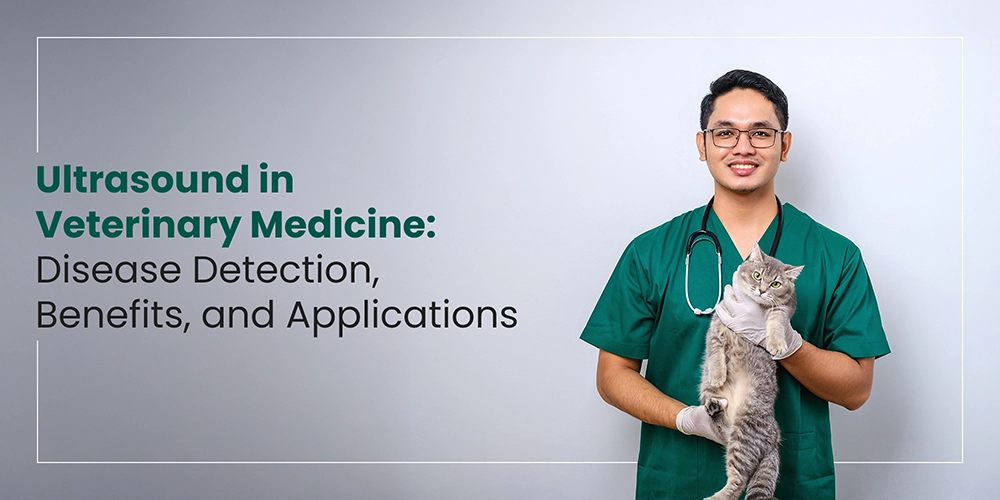Ultrasound is an important imaging technique in veterinary medicine. It uses high-frequency sound waves (2–18 MHz) to make real-time images of internal organs, tissues, and fluid-filled structures of animals. It is a non-invasive and radiation-free diagnostic method that can detect many pathological conditions in companion animals and farm animals.
Diseases Detected by Veterinary Ultrasound
Ultrasound is best suited for evaluating soft tissues and is often used to detect the following animal disorders and conditions:
1. Abdominal Disorders
- Hepatic Diseases: Fatty liver, hepatitis, hepatic neoplasia.
- Renal Conditions: Chronic kidney disease (CKD), nephrolithiasis, pyelonephritis.
- Splenic Abnormalities: Splenomegaly, splenic torsion, and neoplastic lesions.
- Gastrointestinal Issues: Intussusception, foreign bodies, neoplasia, and inflammatory bowel disease (IBD).
2. Cardiac Conditions (Echocardiography)
- Congenital Heart Defects: Patent ductus arteriosus (PDA), ventricular septal defects (VSD).
- Acquired Diseases: Cardiomyopathy, valvular insufficiency, pericardial effusion.
3. Reproductive Health
- Pregnancy Detection: As early as 25 days in dogs and cats.
- Uterine Pathologies: Pyometra, endometritis and fetal abnormalities.
- Testicular Abnormalities: Neoplasia, torsion, orchitis.
4. Oncology
- Differentiates benign vs malignant masses, and guides biopsies.
- Tumor staging and monitoring treatment response.
5. Musculoskeletal and Ocular
- Muscle tears, tendon injuries, joint effusion.
- Ocular ultrasound for retrobulbar masses or trauma.
Applications and Advantages
Its multiple applications and advantages have made veterinary ultrasound very generally used in all fields of practice:
1. Real-Time Imaging
- Allows dynamic study of organ motion (e.g., cardiac cycles, fetal movement, peristalsis).
- Assists in guided biopsies and fluid aspirates.
2. Non-Invasive & Safe
- No ionizing radiation.
- Safe for repeated use in tricky situations like pregnancy and paediatrics.
3. Point-of-Care Versatility
- The very portable ultrasound machines make field diagnosis possible in large animal.
- Used in emergencies for a quick check (e.g., abdominal fluid, thoracic trauma).
4. Improved Diagnostic Accuracy
- Increases sensitivity and specificity of physical examination.
- Enhance surgical planning and post-operative monitoring.
5. Cost-Effective
- Lower operational costs than MRI or CT.
- Ideal for routine diagnostics in small animal practice.
6. Cross-Species Use
- In dogs, cats, horses, cattle, goats and exotics, and zoo animals.
Some Usually Asked FAQs
Is ultrasound safe for all animals?
Yes, being non-invasive and painless, it uses no radiation, so it is completely safe for pets, farm animals, and wildlife.
What animals can undergo ultrasound exams?
Any animal can undergo diagnostic ultrasound techniques from dogs and cats to horses to cows and goats, reptilian species, birds, and zoo creatures.
Can ultrasound be used to detect cancer in pets?
Yes, it assists in detecting tumours and guiding biopsy and treatment monitoring for cancers of the liver, spleen, and others.
When is pregnancy detected?
Ultrasound can detect canine or feline pregnancy from around 25 days post-breeding onwards with fetal heartbeats showing a bit later.
How long does a veterinary ultrasound take?
Generally, 20 to 40 minutes, depending on the region scanned and cooperation of the patient; longer periods may be needed with sedation.
Does it require sedation to conduct ultrasound in animals?
Not always. Most animals just tolerate it well. Sedation can be considered if they are too anxious or in pain or just do not want to cooperate.
What is the difference between X-rays and ultrasound?
X-rays generate images of bones and air-filled organs while ultrasound creates images of soft tissues, such as the liver, kidneys, heart, and reproductive organs.
Does ultrasound guide treatment?
Yes, guiding fine needle aspiration, biopsy, abscess drainage, and even emergency decision-making in trauma or organ rupture.

